Context-Aware Data Dissemination for ICN-Based Vehicular Ad Hoc Networks
Abstract
:1. Introduction
- We propose a mechanism to reduce the number of Interest packets forwarded at the intermediate nodes while keeping the successful data delivery ratio at an acceptable level by limiting the number of nodes around the current forwarding node that broadcast the Interest packet further. This suppresses the potential broadcast storms caused by Interest packets.
- We propose a packet-forwarding mechanism to reduce the number of hops that Interest packets are forwarded before reaching the data source, and “reverse-path routing” for Data packets by making use of the geo-position information of the vehicles and modifying the Pending Interest Table (PIT). This further reduces the number of Interest and Data packets and increases the accuracy of data delivery.
- Context-aware algorithms are introduced in both the packet-forwarding and limitation mechanisms. The algorithms consider the environmental, network, and content contexts surrounding the vehicle in terms of the number and distribution of vehicles nearby. This context-awareness of the mechanisms maintains the high performance of data delivery irrespective of road conditions.
- The proposed mechanisms are evaluated by implementing the mechanisms in an ns-3 based simulator and performing simulations for a representative scenario. We use models of data traffic and vehicular mobility based on real-world data to ensure realism when validating the proposed mechanism.
2. Related Work
3. Context-Aware Packet Forwarding
- The relative distance to the content holder of the candidate forwarding nodes.
- The number of neighboring vehicles (their density) at the time of data forwarding.
- The location similarity with respect to the content holder of neighboring vehicles.
- The priority of the content being requested or sent in response.
3.1. Distance-Based Forwarding Control
3.2. Forwarding Suppression and Suppression Scope
3.3. Density of Vehicles
3.4. Data Processing and Forwarding Control at Vehicular Nodes
4. Test and Evaluation of the Results
4.1. Simulation Environment and Evaluation Metrics
- Bandwidth usage: The total amount of data (kilobytes) transmitted in the network per unit time (second). It also represents the total number of packets successfully transmitted in the network, which reflects the effectiveness of the redundant packet-forwarding suppression, greedy distance-based packet forwarding, and the reverse-path routing Data packet forwarding.
- Successful content delivery ratio: The ratio of the number of Data packets a node obtains successfully to the number of Interest packet it sends to request the Data. For simplicity, in our tests, we did not segment the content requested through an Interest packet into multiple Data packets.
- Data response time: The time between when an Interest packet is sent for requesting content data and the first Data packet is received. We use the average data response time of multiple requests at a certain density of vehicles to evaluate our method.
- Number of hops for data packets: The number of hops that a Data packet has been forwarded in the network before it reaches the node that sent the Interest.
4.2. Evaluation Results
5. Conclusions and Future Work
Author Contributions
Funding
Acknowledgments
Conflicts of Interest
References
- Cunha, F.; Villas, L.; Boukerche, A. Data Communication in VANETs: Protocols, Application and Challenges. Ad Hoc Netw. 2016, 44, 90–103. [Google Scholar] [CrossRef]
- Grewe, D.; Wagner, M.; Arumaithurai, M.; Psaras, I.; Kutscher, D. Information-Centric Mobile Edge Computing for Connected Vehicle Environments: Challenges and Research Directions. In Proceedings of the Workshop on Mobile Edge Communications (MECOMM’17), Los Angeles, CA, USA, 21–25 August 2017; pp. 7–12. [Google Scholar]
- Yaqoob, L.; Ahmad, L.; Ahmed, E.; Gani, A.; Imran, M.; Guizani, N. Overcoming the Key Challenges to Establishing Vehicular Communication: Is SDN the Answer? IEEE Commun. Mag. 2017, 55, 128–134. [Google Scholar] [CrossRef]
- Ahlgren, B.; Dannewitz, C.; Imbrenda, C.; Kutscher, D.; Ohlman, B. A Survey of Information-centric Networking. IEEE Commun. Mag. 2016, 50, 2–36. [Google Scholar] [CrossRef]
- Zhang, L.; Afanasyev, A.; Burke, J.; Jacobson, V.; Claffy, K.; Crowley, P.; Papadopoulos, C.; Wang, L.; Zhang, B. Named Data Networking. Comput. Commun. Rev. 2014, 44, 66–73. [Google Scholar] [CrossRef]
- Perkins, C.E.; Royer, E.M. Ad hoc on Demand Distance Vector Routing. In Proceedings of the 2nd IEEE Workshop on Mobile Computing Systems and Applications, New Orleans, LA, USA, 25–26 February 1999; pp. 90–100. [Google Scholar]
- Johnson, D.B.; Maltz, D.A. Dynamic Source Routing in Ad Hoc Wireless Networks. Mob. Comput. 1996, 353, 153–181. [Google Scholar]
- Liu, G.; Lee, B.S.; Seet, B.C.; Foh, C.H.; Wong, K.J.; Lee, K.K. A Routing Strategy for Metropolis Vehicular Communications. In Proceedings of the International Conference on Information Networking (ICOIN), Busan, Korea, 18–20 February 2004; pp. 134–143. [Google Scholar]
- Füßler, H.; Mauve, M.; Hartenstein, H.; Kasemann, M.; Vollmer, D. Location Based Routing for Vehicular Ad Hoc Networks. Mob. Comput. Commun. Rev. 2003, 7, 47–49. [Google Scholar] [CrossRef]
- Santos, R.A.; Edwards, A.; Edwards, R.; Seed, L. Performance Evaluation of Routing Protocols in Vehicular Ad Hoc Networks. Int. J. Ad Hoc Ubiquitous Comput. 2005, 1, 80–91. [Google Scholar] [CrossRef]
- Lochert, C.; Mauve, M.; Füßler, H.; Hartenstein, H. Geographic Routing in City Scenarios. Mob. Comput. Commun. Rev. 2005, 9, 69–72. [Google Scholar] [CrossRef]
- Korkmaz, G.; Ekici, E.; Özgüner, F.; Özgüner, Ü. Urban Multi-hop Broadcast Protocol for Inter-vehicle Communication Systems. In Proceedings of the ACM International Workshop on Vehicular Ad Hoc Networks, Philadelphia, PA, USA, 1 October 2004; pp. 76–85. [Google Scholar]
- Little, T.D.C.; Agarwal, A. An Information Propagation Scheme for VANETs. In Proceedings of the 8th IEEE International Conference on Intelligent Transportation Systems (ITSC 2005), Vienna, Austria, 13–16 September 2005. [Google Scholar]
- Karp, B.; Kung, H.T. GPSR: Greedy perimeter stateless routing for wireless networks. In Proceedings of the 6th Annual International Conference on Mobile Computing and Networking (ACM MobiCom ‘00), Boston, MA, USA, 6–11 August 2000; pp. 243–254. [Google Scholar]
- Kukliński, S.; Wolny, G. CARAVAN: A Context-AwaRe Architecture for VANET. In Mobile Ad Hoc Networks Xin Wang; IntechOpen: London, UK, 2011; pp. 125–148. [Google Scholar]
- Pentikousis, K.; Ohlman, B.; Corujo, D.; Boggia, G.; Tyson, G.; Davies, E.; Molinaro, A.; Eum, S. Information-Centric Networking: Baseline Scenarios, RFC7476. Available online: https://tools.ietf.org/html/rfc7476 (accessed on 18 October 2018).
- Amadeo, M.; Campolo, C.; Molinaro, A. Information-centric networking for connected vehicles: A survey and future perspectives. IEEE Commun. Magaz. 2016, 54, 98–104. [Google Scholar] [CrossRef]
- Jacobson, V.; Smetters, D.K.; Thornton, J.D.; Plass, M.F.; Briggs, N.H.; Braynard, R.L. Networking Named Content. In Proceedings of the 5th International Conference on Emerging Networking Experiments and Technologies (ACM CoNEXT 2009), Rome, Italy, 1–4 December 2009; pp. 1–12. [Google Scholar]
- Yan, Z.; Zeadally, S.; Park, Y.-J. A Novel Vehicular Information Network Architecture based on Named Data Networking (NDN). IEEE Internet Things 2014, 1, 525–532. [Google Scholar] [CrossRef]
- Wang, J.; Wakikawa, R.; Zhang, L. DMND: Collecting Data from Mobiles Using Name Data. In Proceedings of the IEEE Vehicular Networking Conference, Jersey City, NJ, USA, 13–15 December 2010. [Google Scholar]
- Wang, L.; Afanasyev, A.; Kuntz, R.; Vuyyuru, R.; Wakikawa, R.; Zhang, L. Rapid Traffic Information Dissemination Using Named Data. In Proceedings of the 1st ACM Workshop on Emerging Name-Oriented Mobile Networking Design–Architecture, Algorithms, and Applications (ACM MobiHoc NoM Workshop), Hilton Head, SC, USA, 11–14 June 2012. [Google Scholar]
- Amadeo, M.; Campolo, C.; Molinaro, A. Enhancing Content-Centric Networking for Vehicular Environments. Comput. Netw. 2013, 57, 3223–3234. [Google Scholar] [CrossRef]
- Grassi, G.; Pesavento, D.; Pau, G.; Vuyyuru, R.; Wakikawa, R.; Zhang, L. VANET via Named Data Networking. In Proceedings of the INFOCOM Workshop on Name Oriented Mobility (NOM), Toronto, ON, Canada, 27 April–2 May 2014. [Google Scholar]
- Grassi, G.; Pesavento, D.; Pau, G.; Zhang, L.; Fdida, S. Navigo: Interest Forwarding by Geolocations in Vehicular Named Data Networking. In Proceedings of the IEEE World of Wireless Mobile and Multimedia Networks (WoWMoM), Boston, MA, USA, 14–17 June 2015. [Google Scholar]
- Yu, Y.; Mario, G. Information-centric VANETs: A Study of Content Routing Design Alternatives. In Proceedings of the 2016 International Conference on Computing, Networking and Communications (ICNC 2016), Kauai, HI, USA, 15–18 February 2016; pp. 1–5. [Google Scholar]
- Li, Y.; Su, X.; Lindgren, A.; Shi, X.; Cai, X.; Riekki, J.; Que, X. Distance Assisted Information Dissemination with Broadcast Suppression for ICN-based VANET. In Proceedings of the International Conference on Internet of Vehicles (IoV2016), Nadi, Fiji, 8–10 December 2016. [Google Scholar]
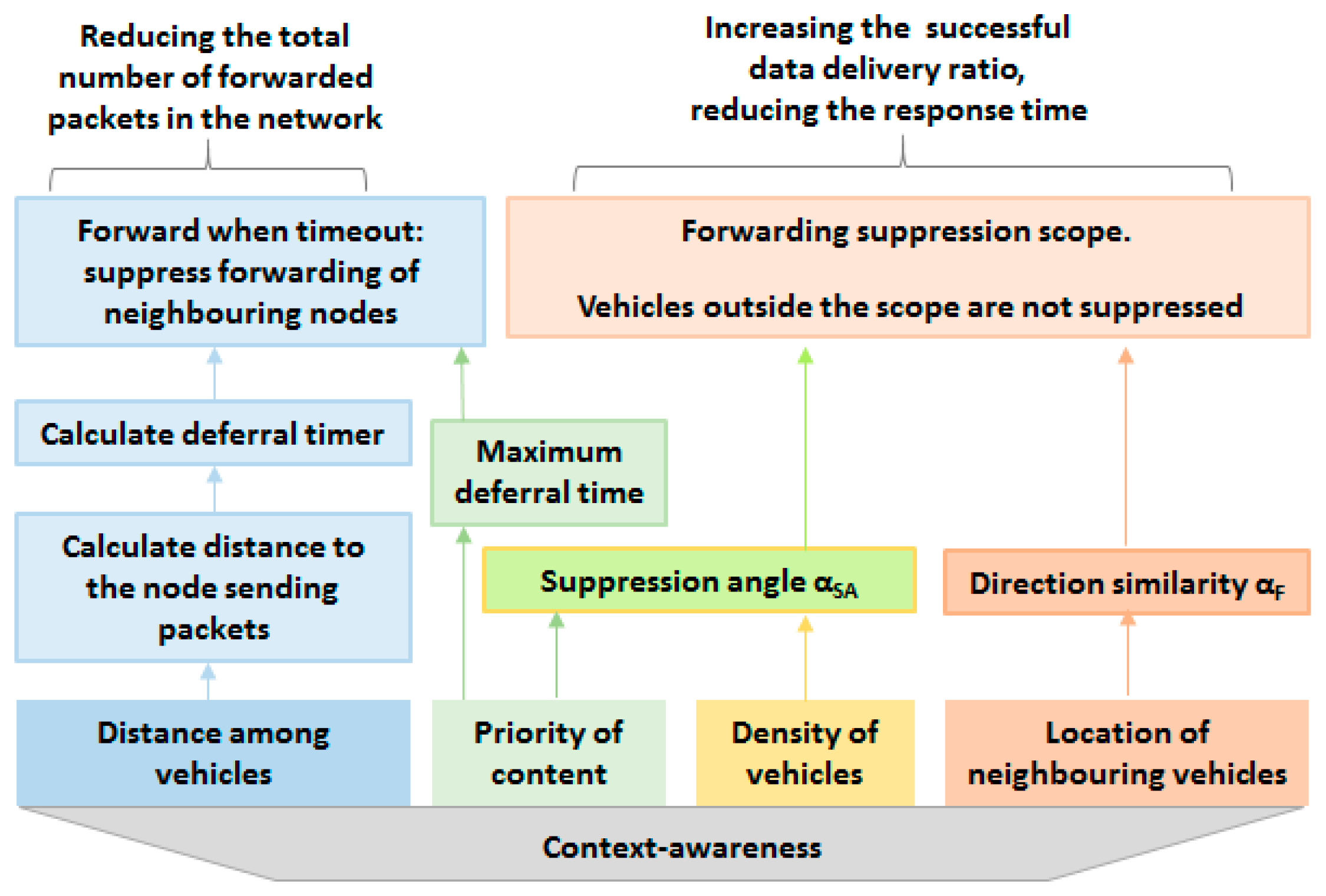





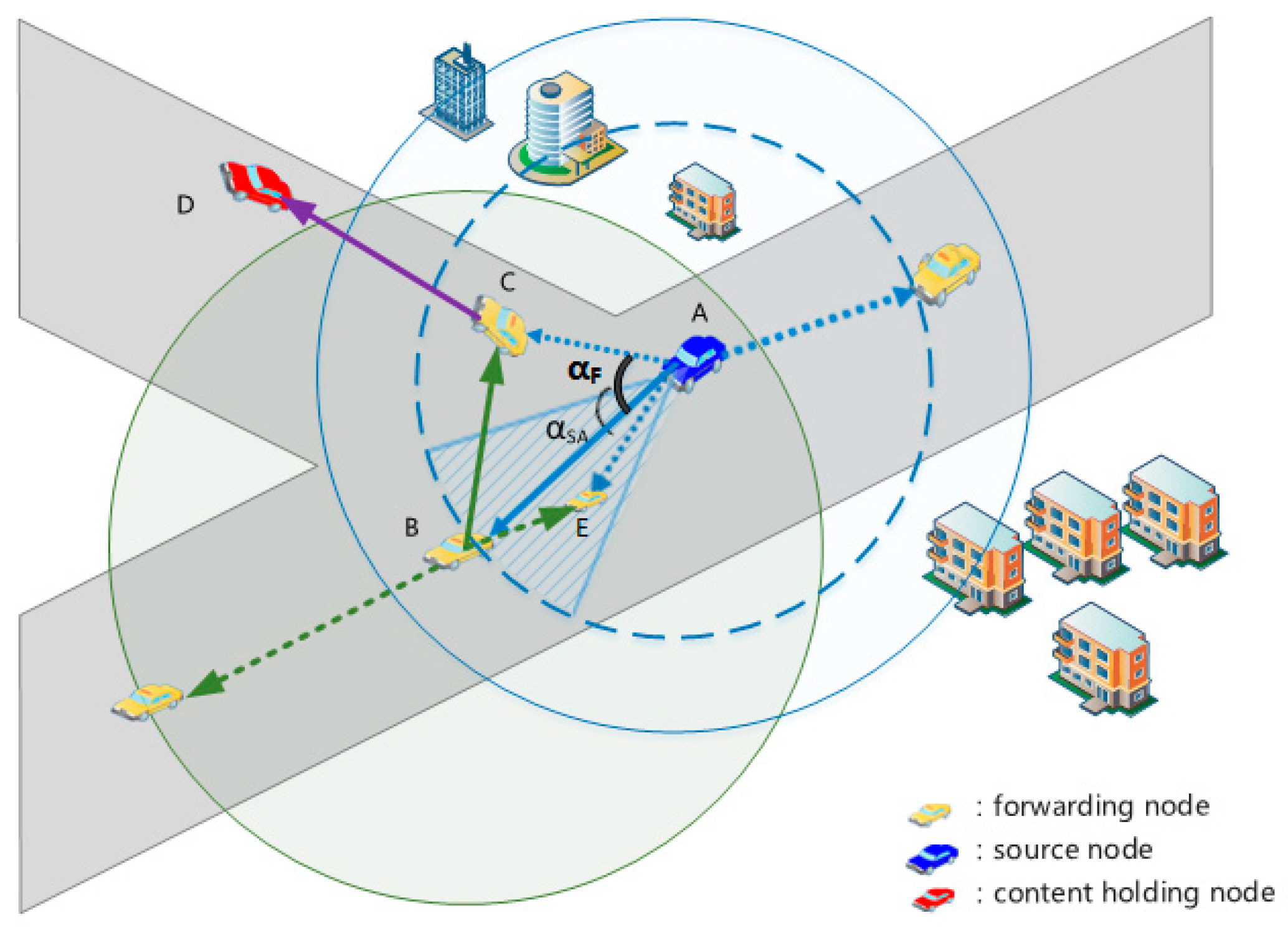

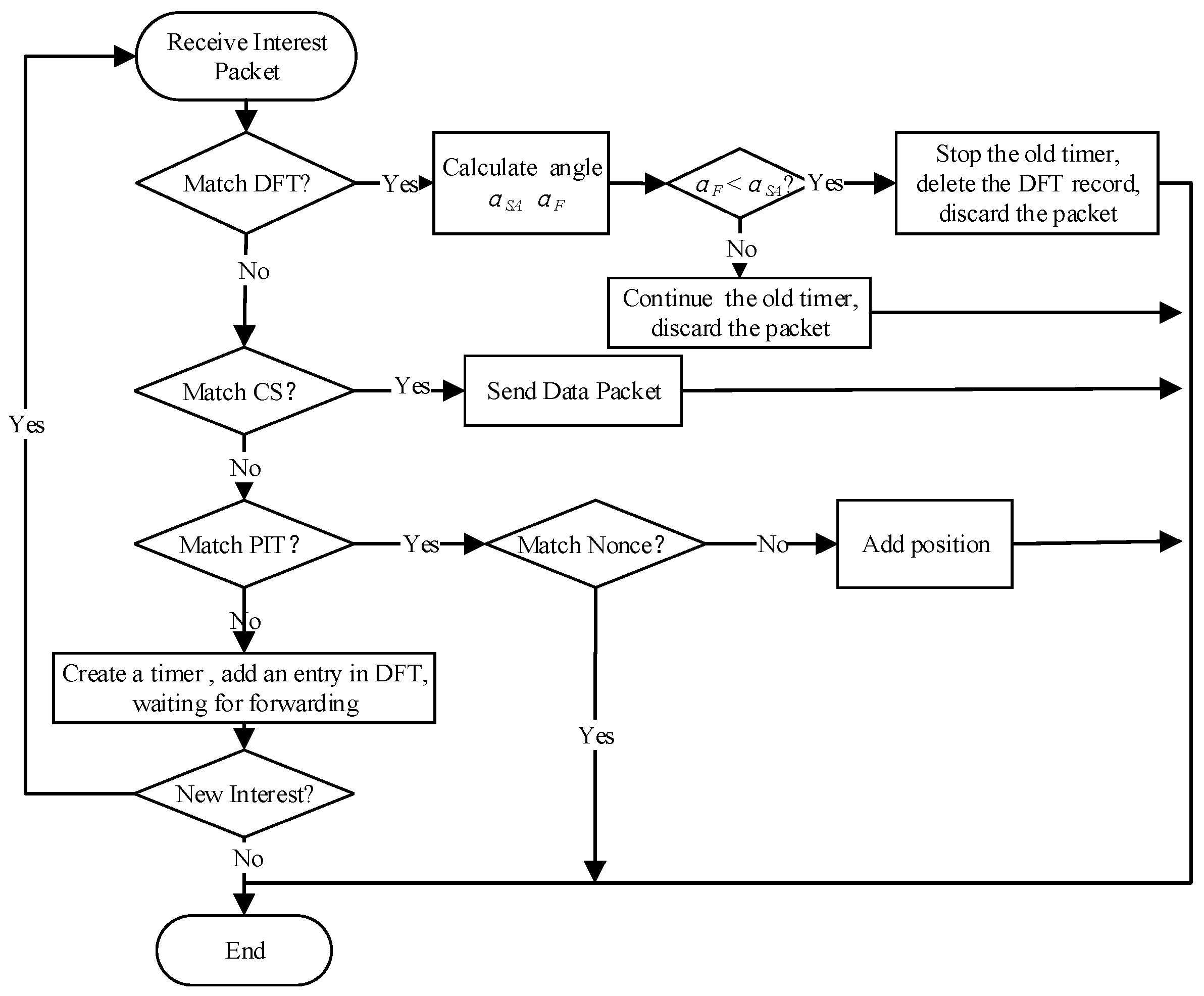
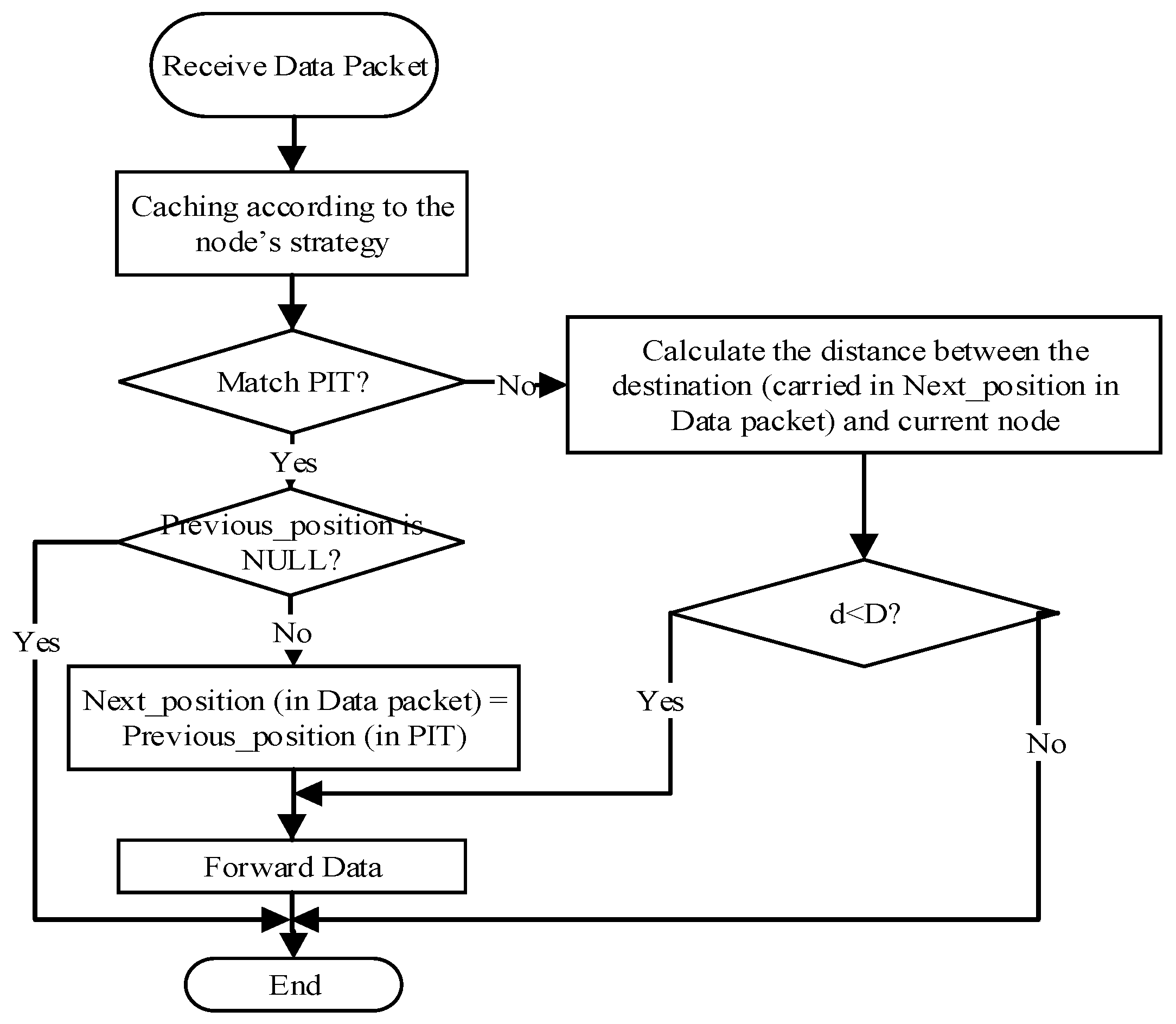
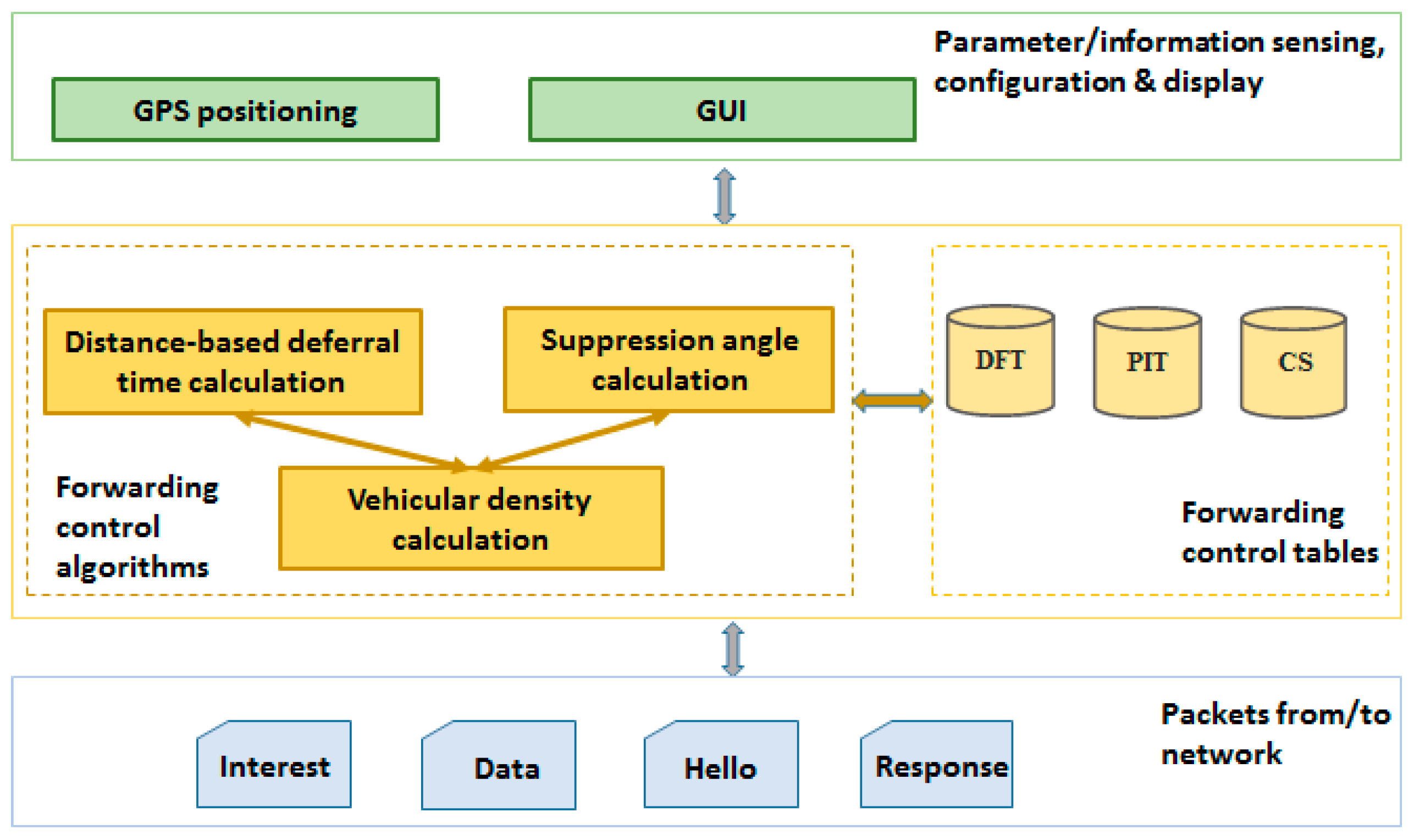
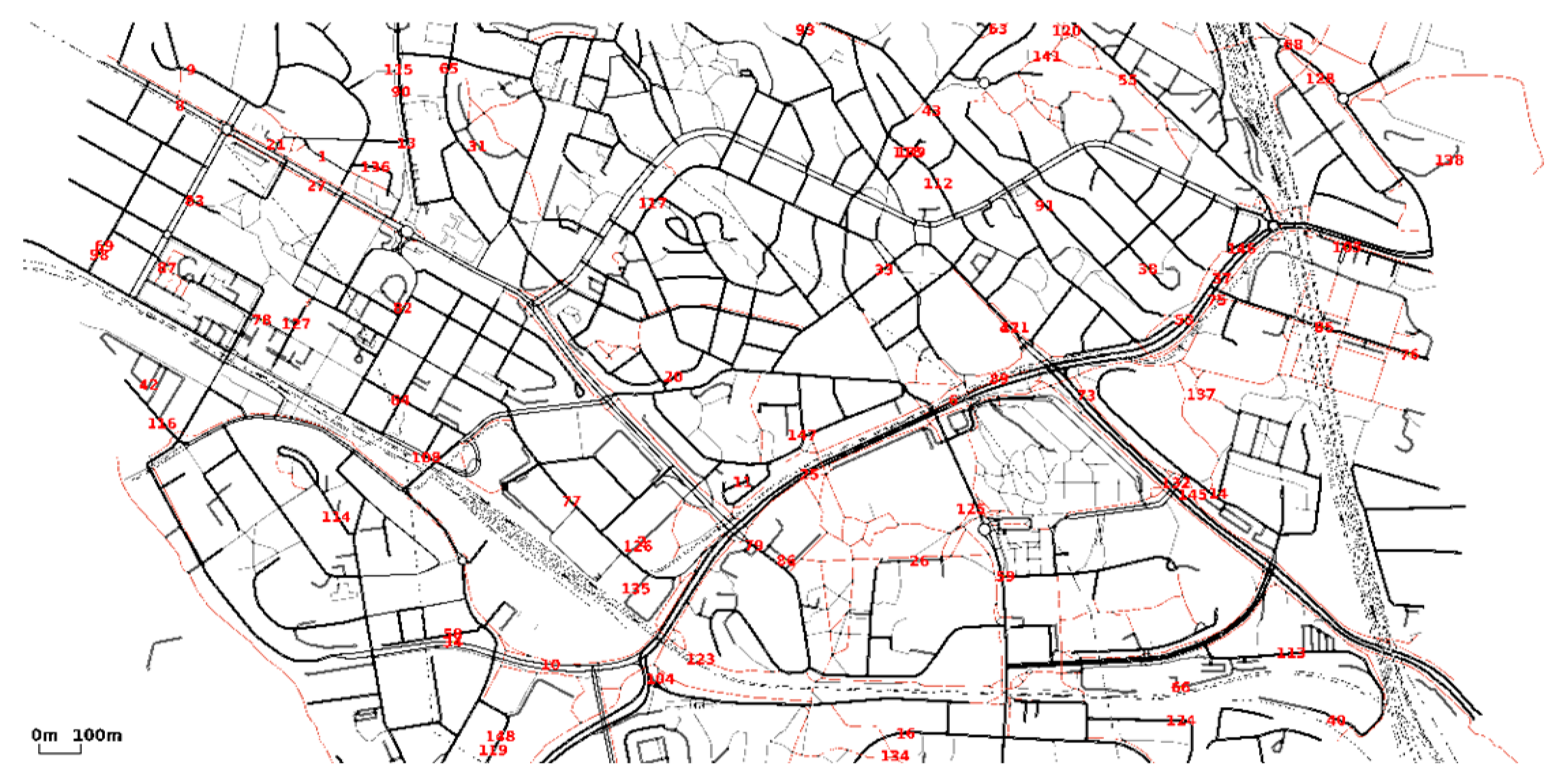
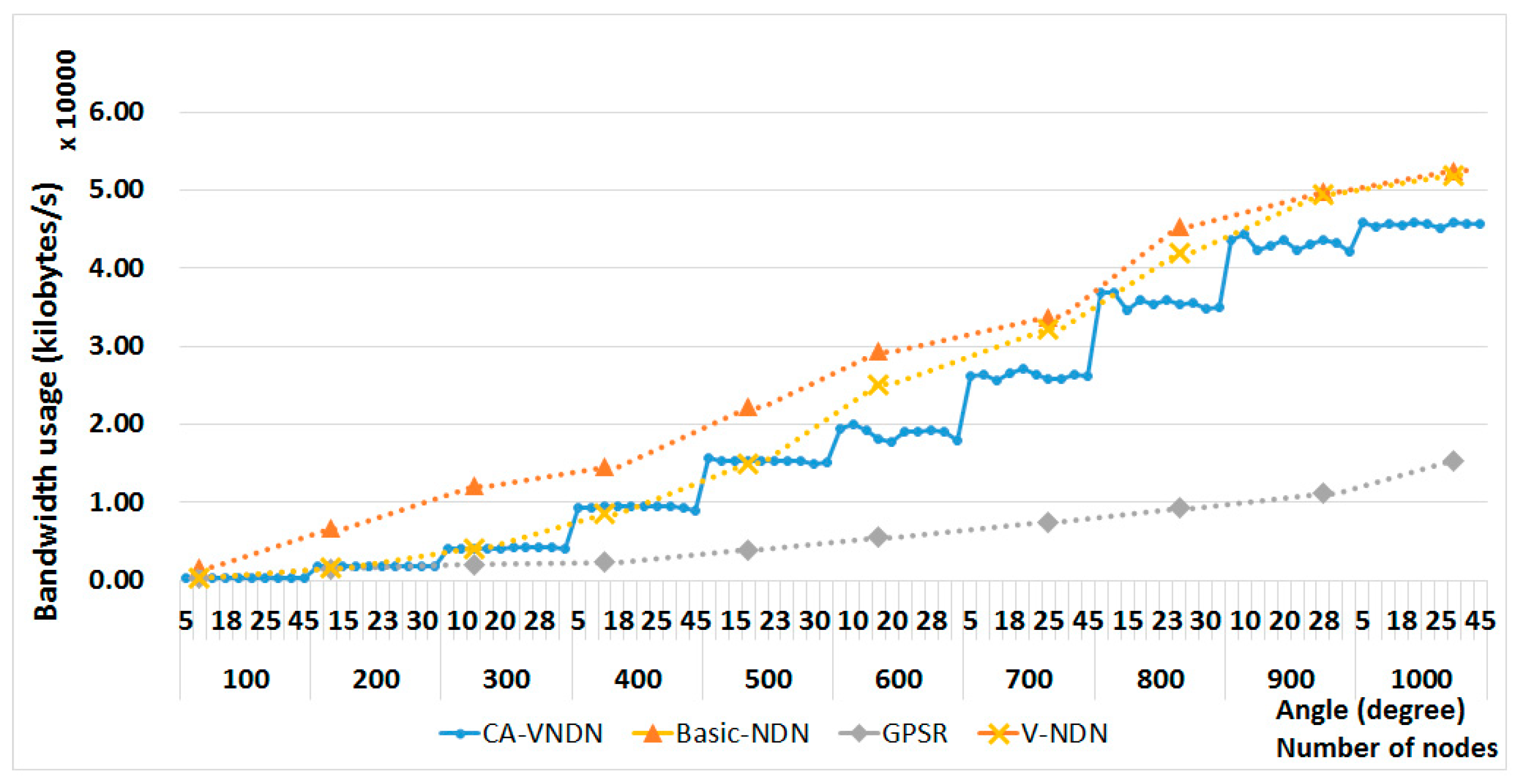
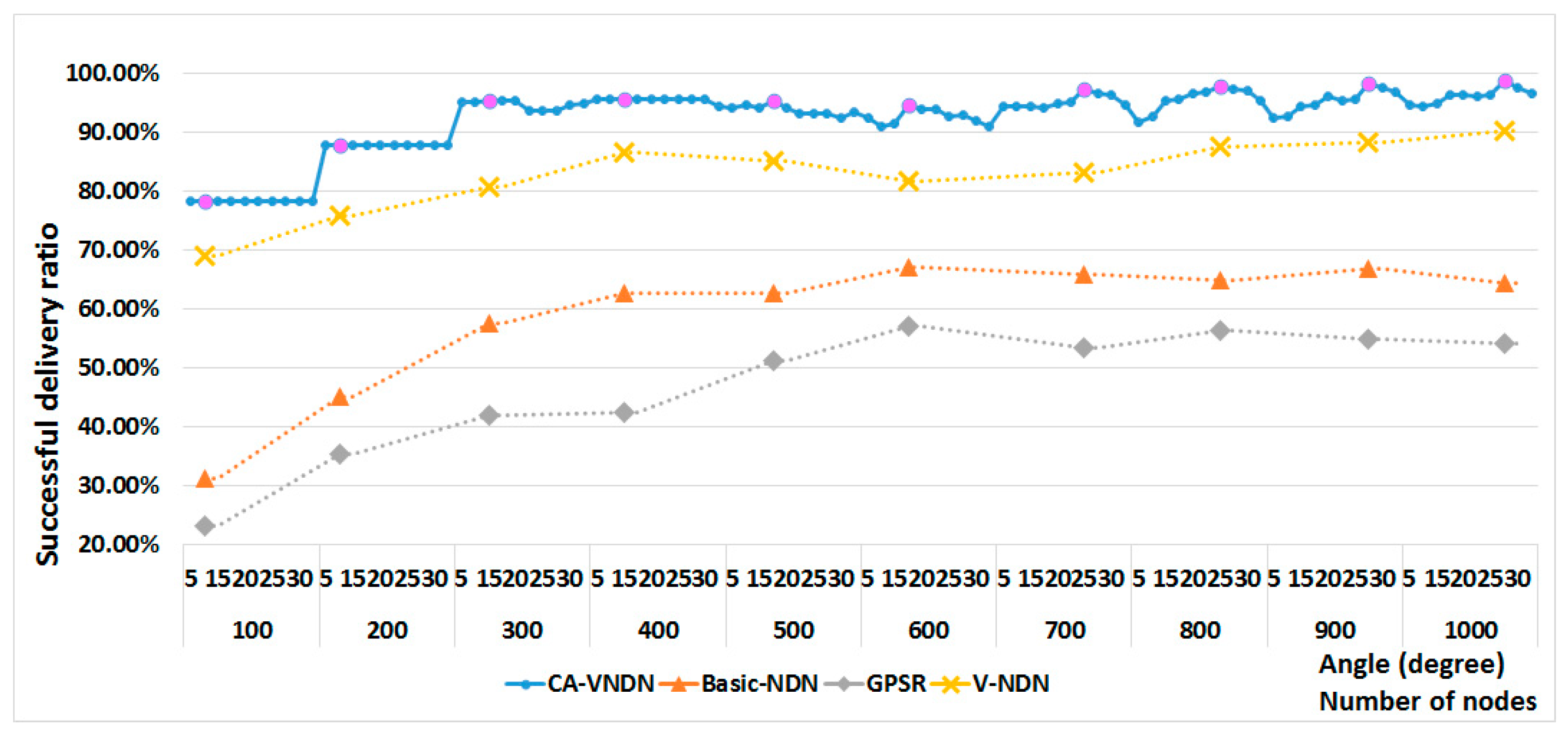
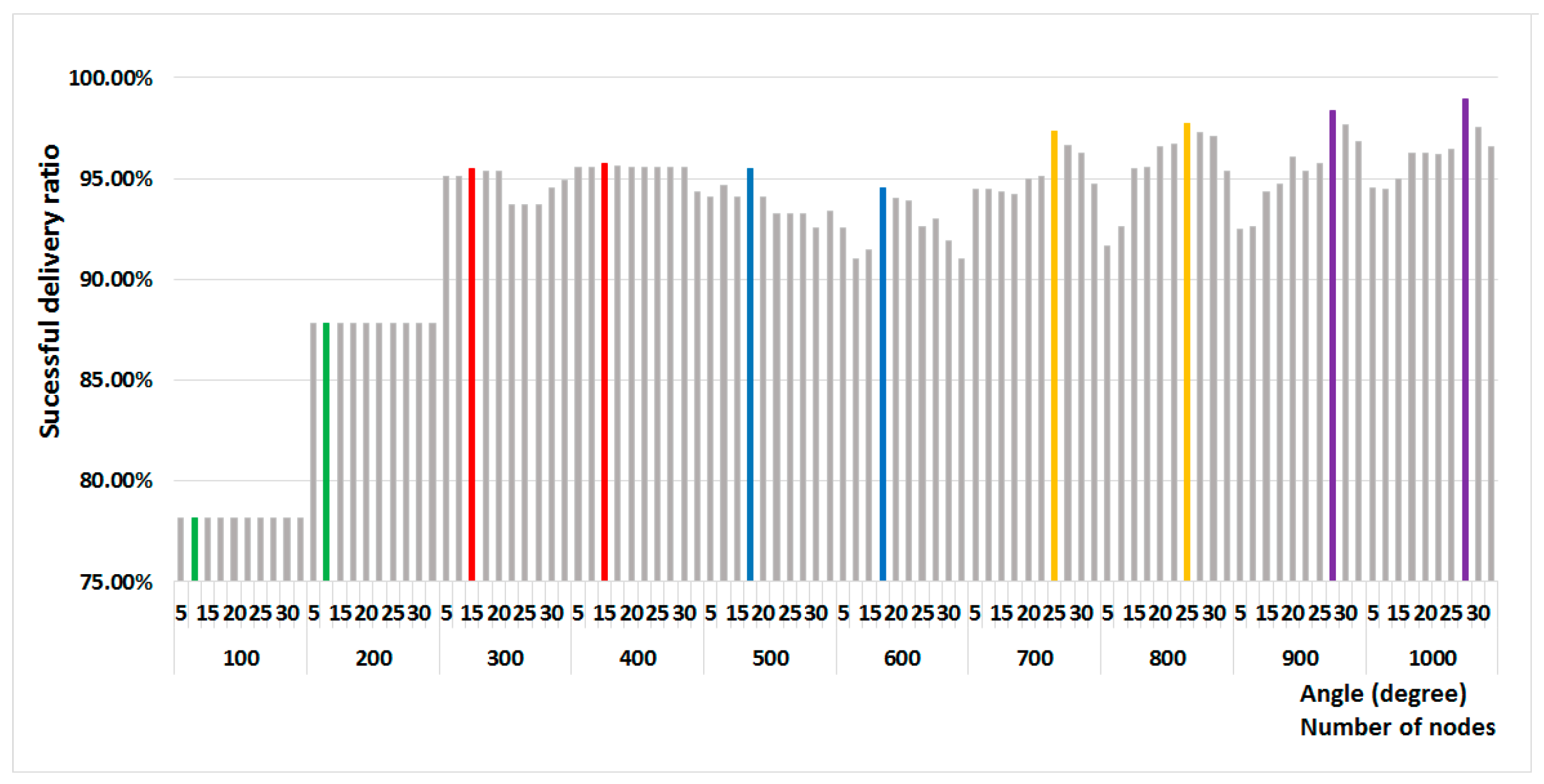
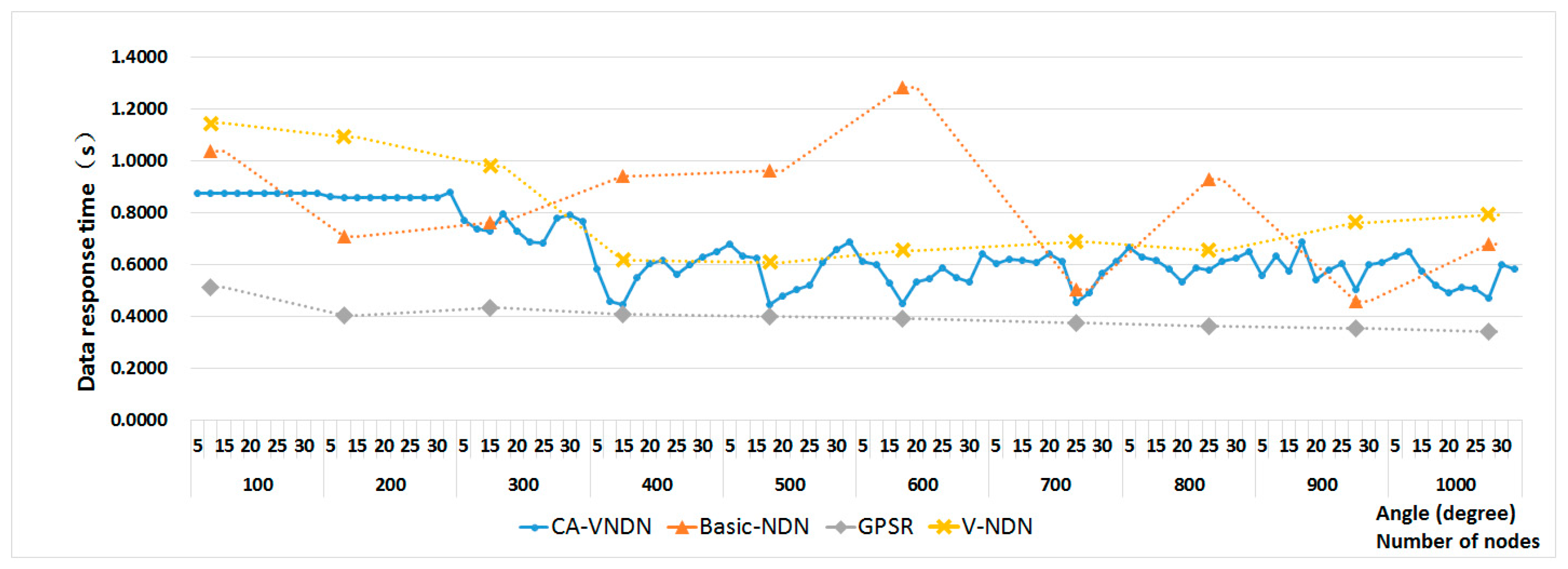
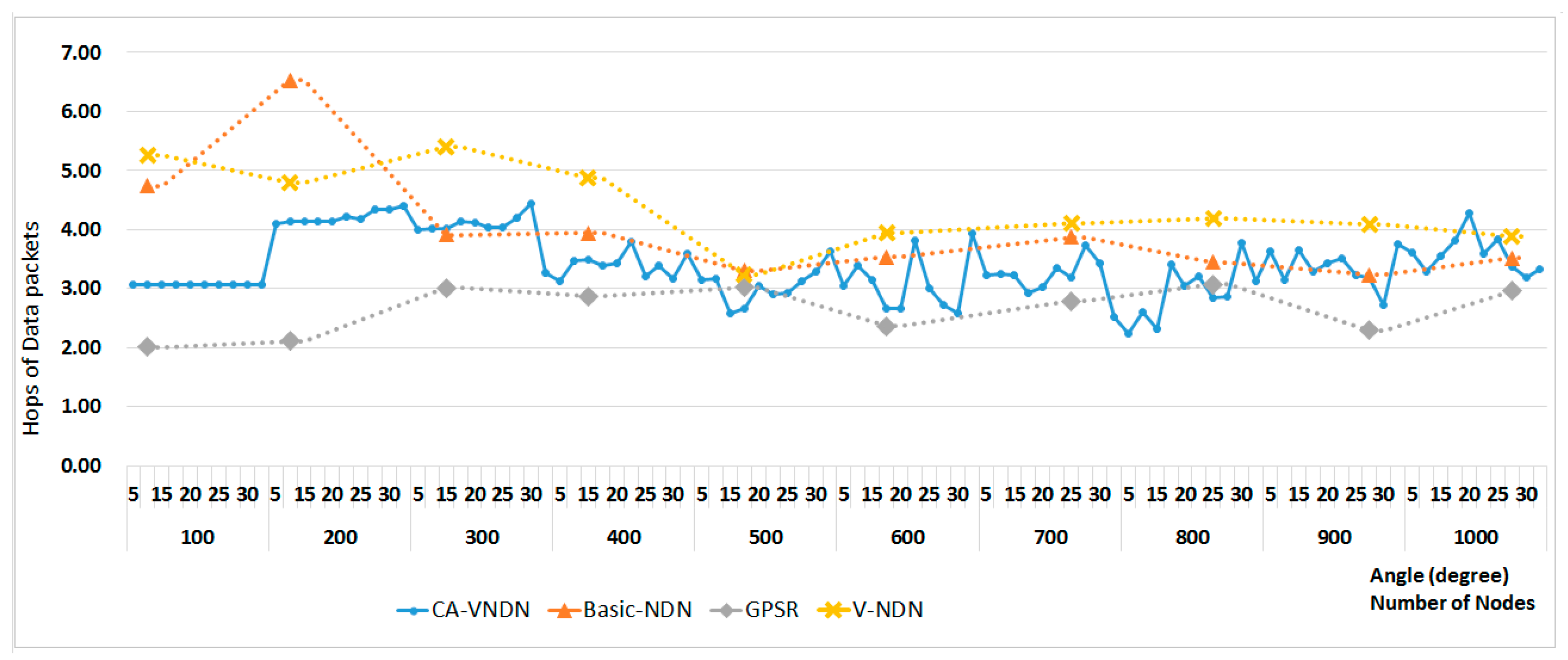
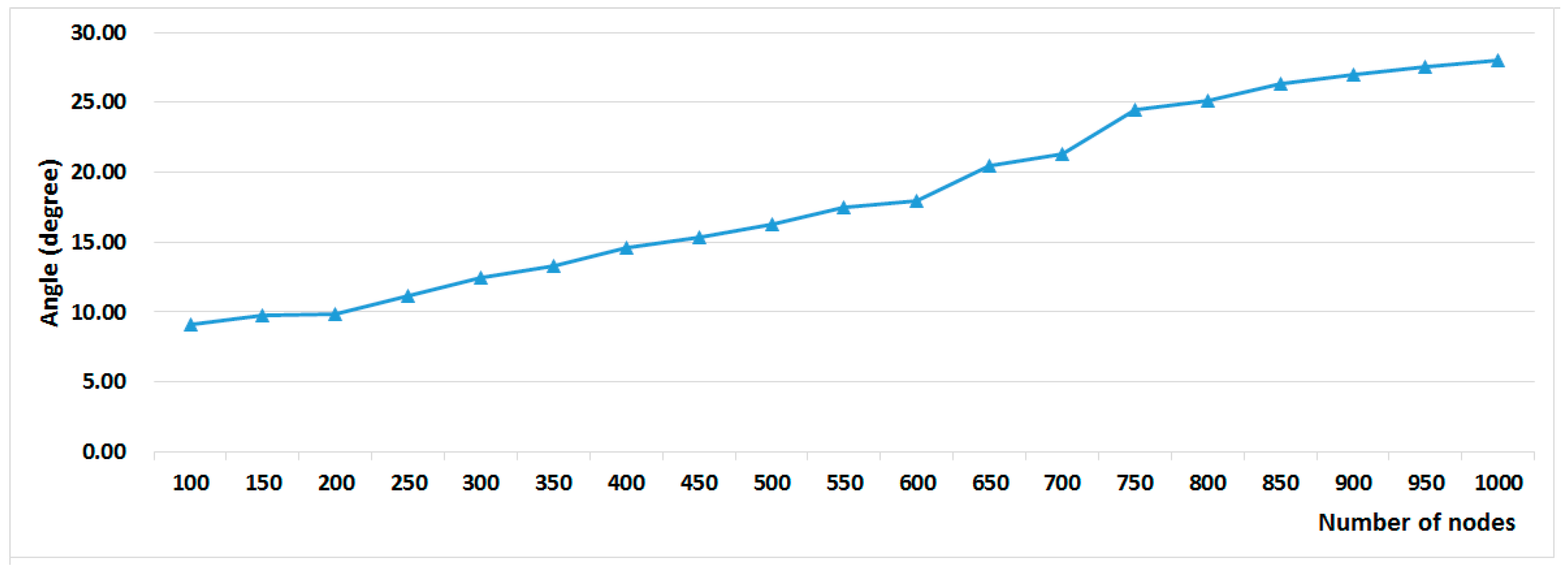
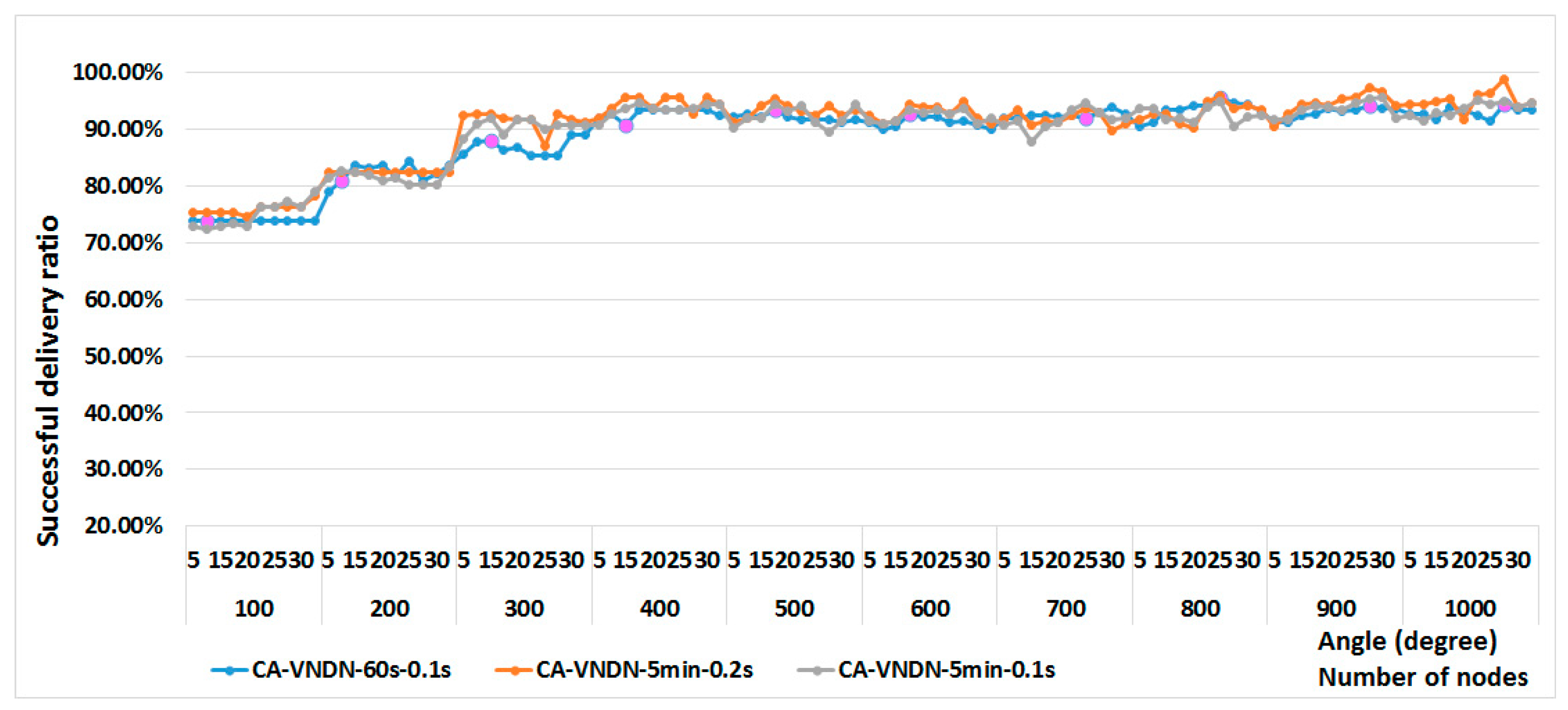
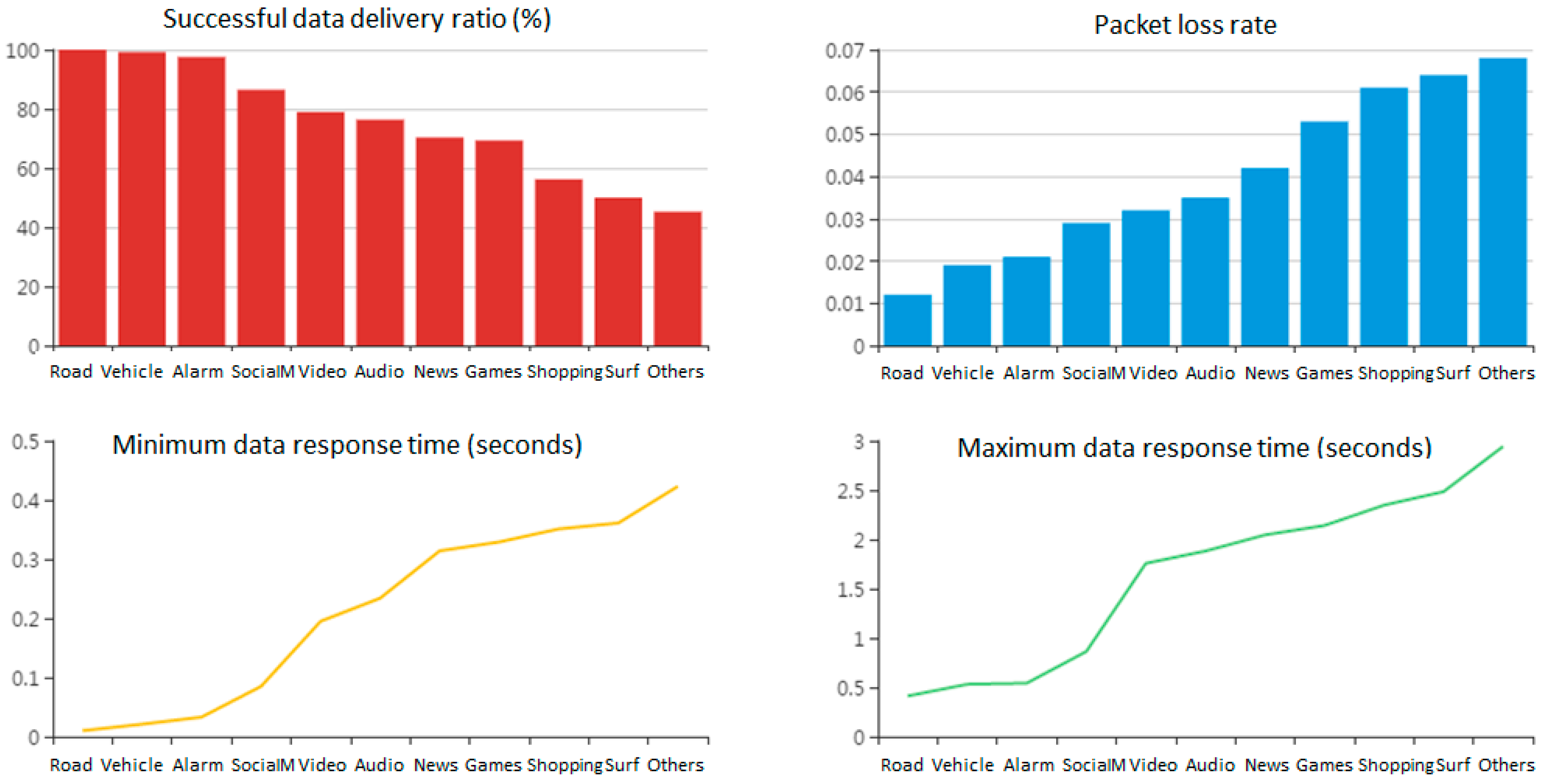
| Parameters | Value |
|---|---|
| WLAN Protocol | IEEE 802.11p |
| Data Link Types | DLT_IEEE802_11_RADIO |
| Wireless transmission model | ConstantSpeedPropagationDelayModel |
| Signal propagation loss model | RangePropagationLossModel |
| Receiving gain | 0 db |
| Data packet length | 1200 bytes |
| Remote station manager | ConstantRateWifiManager |
| Vehicle speed | 30–80 km/h |
| Time | 60 s and 300 s |
| Radio transmission range R | 300 m |
| Dm | 250 m |
| m | 8 ms |
| c | 10 |
| ds | 10/πR2 (R = 300 m) |
| λ | 5 s |
| Information Types | Applications | Priority | Operations |
|---|---|---|---|
| Road conditions | Baidu, Gaode maps | 1 |  |
| Vehicle conditions | Vehicle Check Master | 2 |  |
| Alarms | Danger Alarmer | 3 |  |
| Social media info. | QQ, WeChat, DingDing | 10 |  |
| Video clips | YOUKU, iQIYI | 11 |  |
| Audio clips | NetEase’s cloud music, QQ music | 12 |  |
| News | Headline today, NetEast news | 13 |  |
| Games | King’s glory, Happy and Happy | 14 |  |
| Online shopping | Taobao, Jingdong, Meituan | 15 |  |
| Web surfing | Safari chrome | 16 |  |
| Others | Random select from above | 20 |  |
© 2018 by the authors. Licensee MDPI, Basel, Switzerland. This article is an open access article distributed under the terms and conditions of the Creative Commons Attribution (CC BY) license (http://creativecommons.org/licenses/by/4.0/).
Share and Cite
Li, Y.; Shi, X.; Lindgren, A.; Hu, Z.; Zhang, P.; Jin, D.; Zhou, Y. Context-Aware Data Dissemination for ICN-Based Vehicular Ad Hoc Networks. Information 2018, 9, 263. https://doi.org/10.3390/info9110263
Li Y, Shi X, Lindgren A, Hu Z, Zhang P, Jin D, Zhou Y. Context-Aware Data Dissemination for ICN-Based Vehicular Ad Hoc Networks. Information. 2018; 9(11):263. https://doi.org/10.3390/info9110263
Chicago/Turabian StyleLi, Yuhong, Xinyue Shi, Anders Lindgren, Zhuo Hu, Peng Zhang, Di Jin, and Yingchao Zhou. 2018. "Context-Aware Data Dissemination for ICN-Based Vehicular Ad Hoc Networks" Information 9, no. 11: 263. https://doi.org/10.3390/info9110263
APA StyleLi, Y., Shi, X., Lindgren, A., Hu, Z., Zhang, P., Jin, D., & Zhou, Y. (2018). Context-Aware Data Dissemination for ICN-Based Vehicular Ad Hoc Networks. Information, 9(11), 263. https://doi.org/10.3390/info9110263





